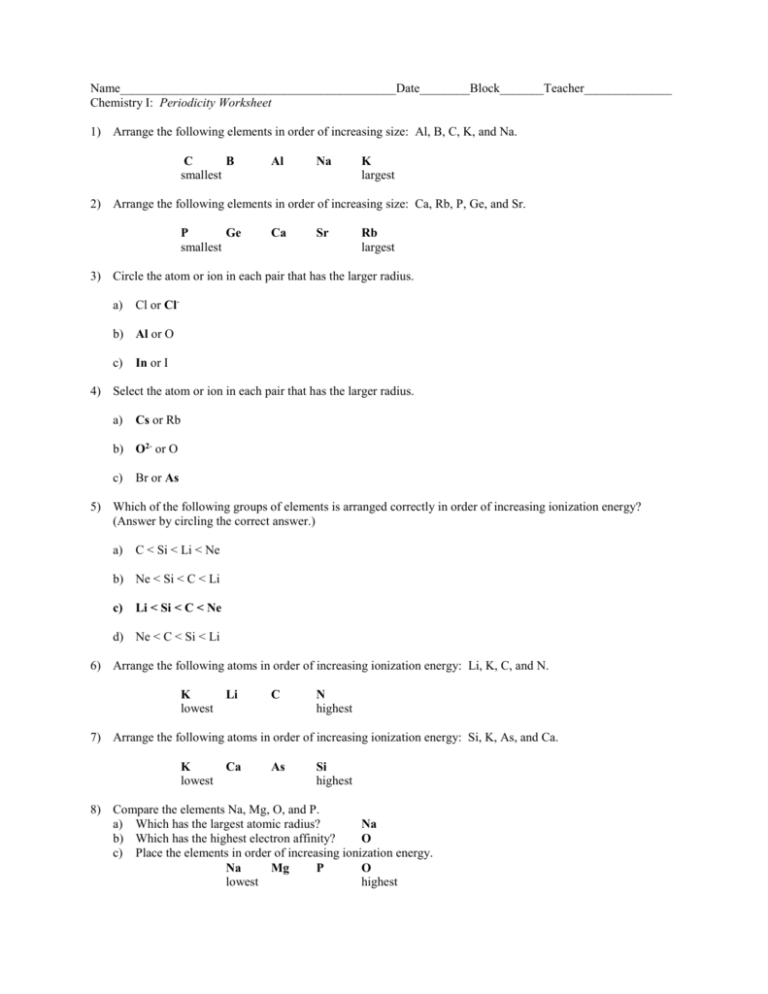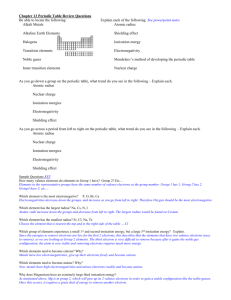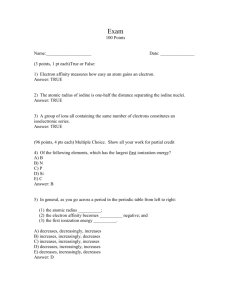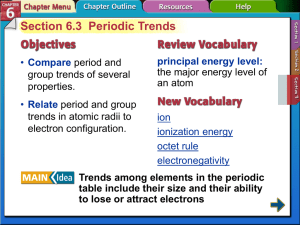PeriodicityWksht Key
advertisement

Name____________________________________________Date________Block_______Teacher______________ Chemistry I: Periodicity Worksheet 1) Arrange the following elements in order of increasing size: Al, B, C, K, and Na. C B smallest Al Na K largest 2) Arrange the following elements in order of increasing size: Ca, Rb, P, Ge, and Sr. P Ge smallest Ca Sr Rb largest 3) Circle the atom or ion in each pair that has the larger radius. a) Cl or Cl- b) Al or O c) In or I 4) Select the atom or ion in each pair that has the larger radius. a) Cs or Rb b) O2- or O c) Br or As 5) Which of the following groups of elements is arranged correctly in order of increasing ionization energy? (Answer by circling the correct answer.) a) C < Si < Li < Ne b) Ne < Si < C < Li c) Li < Si < C < Ne d) Ne < C < Si < Li 6) Arrange the following atoms in order of increasing ionization energy: Li, K, C, and N. K lowest Li C N highest 7) Arrange the following atoms in order of increasing ionization energy: Si, K, As, and Ca. K lowest Ca As Si highest 8) Compare the elements Na, Mg, O, and P. a) Which has the largest atomic radius? Na b) Which has the highest electron affinity? O c) Place the elements in order of increasing ionization energy. Na Mg P O lowest highest 9) Explain each answer briefly. a) Place the following elements in order of increasing ionization energy: F, O, and S. S<O<F : Ionization energy increases moving upwards in a group and right in a period. It is more difficult to pull electrons away from a smaller radius because the nuclear charge is stronger. Also, there are more paired electrons as you move right in a period (making the elements more stable). b) Which has the largest ionization energy: O, S, or Se? O : Oxygen has the smallest atomic radius. Its nuclear charge is highest of these elements because it has more valence electrons (held more tightly). Thus more energy is needed to remove the electrons. c) Which has the greatest electron affinity: Se, Cl, or Br? Cl : Chloride’s outermost shell is closest to the nucleus and has fewer shells than Se and Br. Its nuclear charge is bigger and attracts stronger so more electrons are attracted to it. Also, electron affinity increases going up the group and Cl is above Br in the group. d) Which has the largest radius: O2-, F-, or F O2-: This ion has the lowest nuclear charge. Its low nuclear charge makes it so that its electrons are held far from its nucleus, giving it a large radius. e) Rank the following in order of increasing atomic radius: O, S, and F. S>O>F: Atomic radii increase as you go downwards in a group and to the left in a period because there are more shells as you go down and fewer valence electrons as you move left (which makes for a higher nuclear charge). f) Which has the largest ionization energy: P, Si, S, or Se? P: Phosphorous has half of all its P-Sublevel filled and so it has the largest ionization energy because it takes a lot of ionization energy to remove that many electrons. For Si, not as much ionization energy is needed because its outermost level is 3P2 and it’s easier to remove two electrons than for P (3P3) which has half of its sublevel filled. g) Place the following in order of increasing radius: Ne, O 2-, N3-, or F-. Ne< F-< O2-< N3-: All these elements/ions have the same number of electrons, however Ne has a greater nuclear charge than the others. The electrons in Ne are closer to its nucleus, so its radius is smaller.











